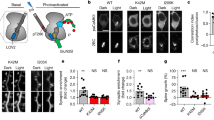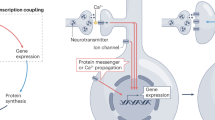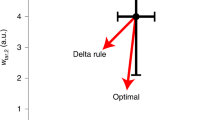Abstract
On the thirtieth birthday of long-term potentiation (LTP), it is appropriate to step back from the fray, evaluate what has been learned and look to the future. Two of us (J.W.L. and J.R.S.) published such an evaluation a few years ago in the hope that the ignorance conferred to us by our status as outsiders to the field might be offset, at least in part, by a freshness of perspective. The responses to that article have been numerous and fascinating, with experts and non-experts raising points in private that would benefit from open discussion. Here, joined by an LTP 'insider' (J.L.), we initiate such a discussion, restating, clarifying and debating some of the points that were raised in the original article.
This is a preview of subscription content, access via your institution
Access options
Subscribe to this journal
Receive 12 print issues and online access
$189.00 per year
only $15.75 per issue
Buy this article
- Purchase on Springer Link
- Instant access to full article PDF
Prices may be subject to local taxes which are calculated during checkout
Similar content being viewed by others
References
Sanes, J. R. & Lichtman, J. W. Can molecules explain long-term potentiation? Nature Neurosci. 2, 597–604 (1999).
Neveu, D. & Zucker, R. S. Long-lasting potentiation and depression without presynaptic activity. J. Neurophysiol. 75, 2157–2160 (1996).
Lee, H. K. et al. Phosphorylation of the AMPA receptor GluR1 subunit is required for synaptic plasticity and retention of spatial memory. Cell 112, 631–643 (2003).
Takahashi, T., Svoboda, K. & Malinow, R. Experience strengthening transmission by driving AMPA receptors into synapses. Science 299, 1585–1588 (2003).
Ostroff, L. E., Fiala, J. C., Allwardt, B. & Harris, K. M. Polyribosomes redistribute from dendritic shafts into spines with enlarged synapses during LTP in developing rat hippocampal slices. Neuron 35, 535–545 (2002).
Choi, S., Klingauf, J. & Tsien, R. W. Fusion pore modulation as a presynaptic mechanism contributing to expression of long-term potentiation. Philos. Trans. R. Soc. 358, 695–705 (2003).
Lisman, J. Long-term potentiation: outstanding questions and attempted synthesis. Philos. Trans. R. Soc. Lond. B 358, 829–842 (2003).
Matsuzaki, M. et al. Dendritic spine geometry is critical for AMPA receptor expression in hippocampal CA1 pyramidal neurons. Nature Neurosci. 4, 1086–1092 (2001).
Malenka, R. C. & Nicoll, R. A. Long-term potentiation — a decade of progress? Science 285, 1870–1874 (1999).
Malinow, R., Mainen, Z. F. & Hayashi, Y. LTP mechanisms: from silence to four-lane traffic. Curr. Opin. Neurobiol. 10, 352–357 (2000).
Zakharenko, S. S., Zablow, L. & Siegelbaum, S. A. Visualization of changes in presynaptic function during long-term synaptic plasticity. Nature Neurosci. 4, 711–717 (2001).
Emptage, N. J., Reid, C. A., Fine, A. & Bliss, T. V. Optical quantal analysis reveals a presynaptic component of LTP at hippocampal Schaffer-associational synapses. Neuron 38, 797–804 (2003).
Lisman, J. E. & Harris, K. M. Quantal analysis and synaptic anatomy — integrating two views of hippocampal plasticity. Trends Neurosci. 16, 141–147 (1993).
Hartwell, L. H., Hopfield, J. J., Leibler, S. & Murray, A. W. From molecular to modular cell biology. Nature 402, 47–52 (1999).
Strohman, R. C. Organization becomes cause in the matter. Nature Biotechnol. 18, 575–576 (2000).
Nurse, P. Reductionism and explanation in cell biology. Novartis Found. Symp. 213, 93–101; discussion 102–105 (1998).
Jung, J. C. & Schnitzer, M. J. Multiphoton endoscopy. Opt. Lett. 28, 902–904 (2003).
Giese, K. P., Fedorov, N. B., Filipkowski, R. K. & Silva, A. J. Autophosphorylation at Thr286 of the α-calcium-calmodulin kinase II in LTP and learning. Science 279, 870–873 (1998).
Nakazawa, K. et al. Requirement for hippocampal CA3 NMDA receptors in associative memory recall. Science 12, 211–218 (2002).
Author information
Authors and Affiliations
Corresponding author
Rights and permissions
About this article
Cite this article
Lisman, J., Lichtman, J. & Sanes, J. LTP: perils and progress. Nat Rev Neurosci 4, 926–929 (2003). https://doi.org/10.1038/nrn1259
Issue Date:
DOI: https://doi.org/10.1038/nrn1259
This article is cited by
-
Psychoneural reduction: a perspective from neural circuits
Biology & Philosophy (2019)
-
Calmodulin shuttling mediates cytonuclear signaling to trigger experience-dependent transcription and memory
Nature Communications (2018)
-
Manipulations of spinal cord excitability evoke developmentally-dependent compensatory changes in the lamprey spinal cord
Journal of Comparative Physiology A (2012)
-
Imaging synaptic plasticity
Molecular Brain (2011)
-
Sequestration of CaMKII in dendritic spines in silico
Journal of Computational Neuroscience (2011)



